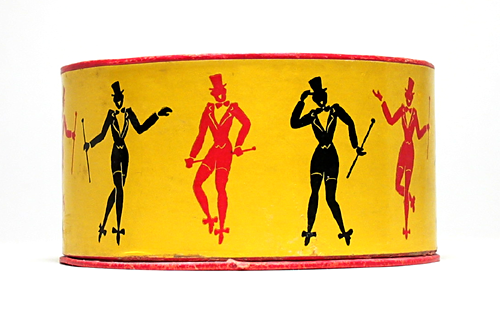Fri 22 Jan, 2016
Hi-Hat Face Powder
Comments (0) Filed under: Face Powder Boxes, LOS ANGELES MAGAZINETags: Art Deco, Billie Holiday, boogie woogie, Cab Calloway, Cotton Club, dead hoofer, Duke Ellington, Dunbar Hotel, Ella Fitzgerald, Harlem Renaissance, Louis Armstrong, The Savoy
Produced during the 1930s, the bold colors and high concept design make this Hi-Hat face powder box a minor Art Deco masterpiece. In addition to being absolutely stunning, the box introduced me to products made specifically for women of color. Face powders for dark skinned women were produced in shades with exotic names like Parisian Lavender Nite, Harlem Tan, and Spanish Rose.
For me, the Hi-Hat box evokes the Harlem Renaissance, when legendary African American entertainers drew crowds of “swells,”—men in top hats and women in evening gowns—into Harlem’s nightspots.
The silhouetted chorus girls that encircle the Hi-Hat box are representative of the beautiful women who worked in Harlem nightclubs during the ‘20s and ‘30s. The hostesses at the Savoy were legendary; they could take a “dead hoofer” (bad dancer) and have them jitterbugging in no time. Not only were they talented, but they were reputed to be the most gorgeous ladies in Harlem.
 From 1920 to 1955, Central Avenue was the L.A. equivalent of Harlem, where boogie woogie, jazz, and R&B were blasted from juke box speakers through the wee hours of the morning. The avenue was known as “the heart of Saturday night Los Angeles.” One of the classiest places to go for an evening’s revelry was the Dunbar Hotel, L.A.’s answer to the Savoy and Cotton Club in New York. In its heyday the Dunbar was the hub of African American culture in L.A., and it offered entertainment from such artists as Duke Ellington, Louis Armstrong, Ella Fitzgerald, Billie Holiday and Cab Calloway.
From 1920 to 1955, Central Avenue was the L.A. equivalent of Harlem, where boogie woogie, jazz, and R&B were blasted from juke box speakers through the wee hours of the morning. The avenue was known as “the heart of Saturday night Los Angeles.” One of the classiest places to go for an evening’s revelry was the Dunbar Hotel, L.A.’s answer to the Savoy and Cotton Club in New York. In its heyday the Dunbar was the hub of African American culture in L.A., and it offered entertainment from such artists as Duke Ellington, Louis Armstrong, Ella Fitzgerald, Billie Holiday and Cab Calloway.
Imagine the dressing table of a habitue of Central Avenue —among her lipsticks, rouge pots, eye pencils and perfume atomizers, surely there would have been a box of Hi-Hat face powder.


